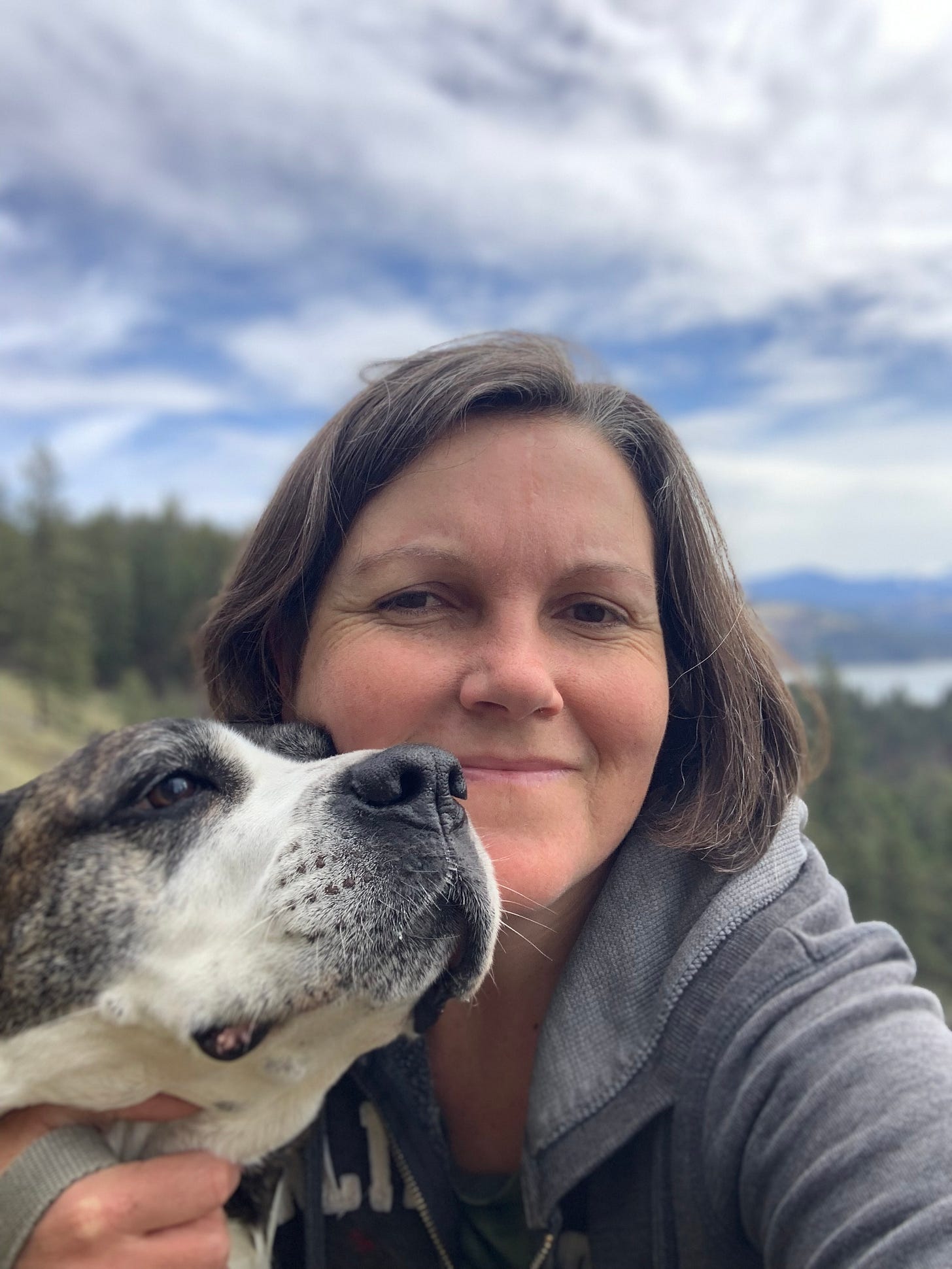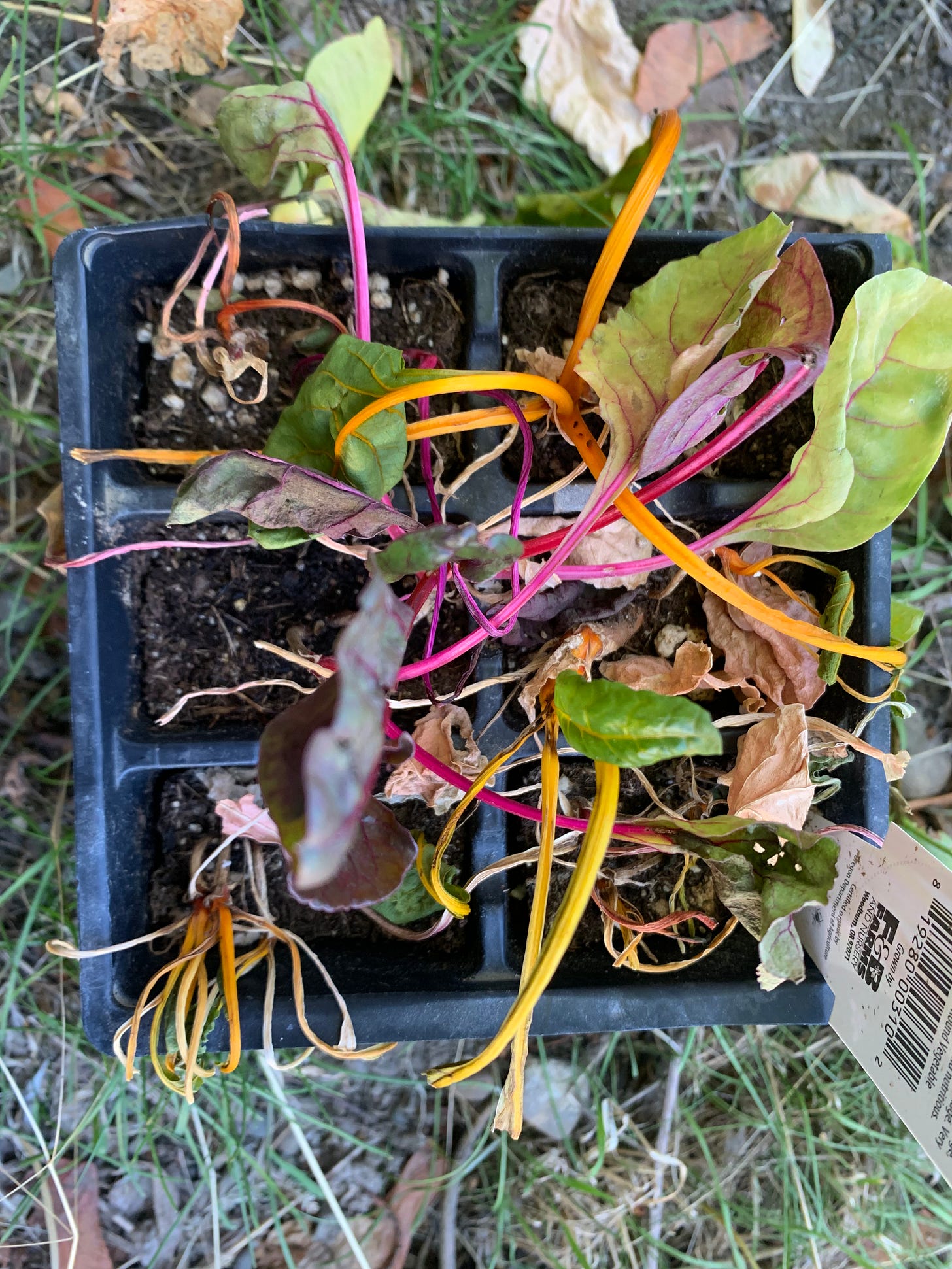Every Year I Swear I Forget How Fall Works
On seasons, shifts in thinking and transition armor
Welcome to Pocketful of Prose, a community for sharing stories. Each week I include an audio version of the post, if you prefer to listen rather than read. Pocketful of Prose is free for everyone, so please share with friends. You can also support this publication by becoming a paid subscriber. If you do, you get one of these sweet stickers designed by my daughter.
Speaking of stickers, I was given this sticker this week.
Pocketful of Prose was featured by Substack Discover, pretty exciting stuff. I got to see my name below Alex Elle’s. The best part of this honor, though, is all the new readers that are joining our community. Welcome! Welcome Lasha, Amy, Adebola and Darya. Welcome cat, coffee and chemistry lovers and cool people who use Amethyst from Steven Universe as your avatar. Welcome “aging dad who wants to help better the world.” Welcome watercolor artists, messy gardeners and curious people who like to make things. Welcome to those of you who are committed to spreading joy. I am so delighted you all are here, and as always, I invite you to stick around and join us for some conversation in the comments. I pose questions each week, but feel free just to say hi and tell us a little about yourself and what wags your tail.
Without further ado, here is today’s pocket.
Every year the seasons change, and yet every year it catches me by surprise. It is like I forget how fall works.
I am a teacher so fall means a return to full-time work. My first week back at work I swear I have forgotten how to do my job. I clean my fridge before I return figuring it won’t occur to me to clean it again until at least winter break. I remove all the food from the fridge and line the counters with the items. Then, I take out all the shelves and drawers and clean them thoroughly. Everything is going smoothly until it’s time to put stuff back. I can’t for the life of me remember how the shelves fit back together. The crisper drawer is completely stuck, and so am I, frustrated that this task, one I have performed many times before, one that should feel like muscle memory, is so hard. I resist the urge to use more force than necessary on the crisper knowing it will easily break. I breathe and remind myself that if I am patient, I will figure it out. Some muscle memory will return, and I will have a fridge epiphany.
Returning to teaching is like cleaning the fridge. I feel like I have some type of seasonal Kermit the Frog/Muppets Take Manhattan amnesia, and by that, I mean nothing like actual amnesia, I’m just kind of lost. Fortunately, it gets a little easier as the days go on. Kermit remembers he loves Piggy. I remember how to do my job.
My seasonal amnesia applies to other aspects of fall as well. I plan a fall garden. I plant seeds and buys some starts. The one thing I forget is that I don’t have time for a fall garden. (In case you also have seasonal amnesia, see paragraph above on my full-time job and the copious amount of time I am spending remembering how to do said job.) Every year, though, I forget, and I plan a fall garden. See sad, sad, photo below of Swiss chard starts that I bought in my fall fog and then ignored for two weeks as I was busy trying to remember all the other things I had forgotten.
One of those things being that growing a fall garden in Spokane is nearly impossible. Because it’s freezing in the morning.
Not actually freezing, that would be pretty much the end of all things garden. That will come soon enough, but just cold enough that anything started can’t really make it to the finish line. Every year I forget just how cold it gets here on a September morning. During my morning yoga session as I’m trying to catch my breath, I can almost see my breath. It is that cold. When I bike to work, I wear flip flops, again seasonal amnesia, and my feet are wishing I had donned a pair of boots or that I at least had the decency to put on a pair of socks.
My seasonal amnesia isn’t just reserved for fall. Last year, I thought I could extend my bike riding season into mid-November. I almost made it out of my neighborhood when I skid across some black ice and face-planted on the asphalt.
That face plant pretty much sums up how I deal with transitions. I kind of suck at them. My senior year of high school, I bawled to my best friend that I didn’t want to go to college because I didn’t want to make any new friends. Changing out my seasonal wardrobe gets the best of me every year, even though it literally means exchanging a box of swimsuits and shorts for a box of sweaters. Somehow in this exchange, every item I own is strewn across my closet floor for months. The first snow always finds me headed to the basement to drag out my winter boots, usually after I have managed unsuccessfully with other footwear, and I am tired of walking around in soggy tennis shoes.
I once went to a Dar Williams concert where she talked about how she wished she could wear armor through life’s transitions. I have never felt so seen.
When I was a young mother of an almost two-and-a-half-year-old, and I was returning to another foggy fall of working full-time and relearning the work I had forgotten how to do, I was on the verge of a mental breakdown. I was trying to be the best teacher and mother that I could be. I felt guilty because I wasn’t able to give my full self to either thing. I would rush home from work to be with my daughter, so I wouldn’t “miss” any more time with her. I was maintaining a pace I couldn’t keep up with. I think it was about this time that I attended that Dar Williams concert, and I bawled my eyes out, when she, also a mother of a young child, talked about desperately needing that transition armor. I realized I needed it too. I needed something to help me transition between the phases and challenges of my day and life, between teacher duties and mom duties. I needed something to shift my thinking. I needed transition armor, and I found it in bath bombs, eucalyptus essential oils and the twenty minutes each day when I chose to take a bathe and be alone with my thoughts before picking my daughter up from day care.
Transitions, whether they involve starting a job or relearning an old one, moving from one challenging role in life to another, or moving from season to season, require a shift in thinking. And these shifts in thinking need to be cultivated with care.
In addition to baths, here is my short list of transition armor.
1. Walking. There is a Latin phrase solvitur ambulando, which translates, “It is solved by walking.” (I learned this from Tom Cox who writes The Villager.) During the pandemic, my husband and I took daily walks together. It was a marriage balm. Our schedules don’t allow this now, but I savor walks when we can take them together, and I look forward to a time in in our lives where we can do this again every day. For now, we each have the company of our dog Cato. On my walks with Cato, I take a moment to pause and take in the world. I think about my life, my relationships, my art. In my daily walks with Cato, I feel like much is solved. Don’t get me wrong, it is not all Zen. She wants to stop and smell everything and pee upwards of twenty times and will occasionally lunge unexpectedly at a biker causing me to drop my phone, which disconnects my headphones just at the moment when Tara Brach is whispering the secret of happiness to me, so I guess not all is solved, but some things are solved. Last year, my friend and I built a weekly walk into our schedules, where we take in the world and process our lives together. Much is solved on these walks as well.
2. Reading. After a long day at work, I like to transition into the second half of my life (the parenting, adulting, spousal bit) with a good book. If I can escape into a book for a few minutes, and really it can be as little as ten, I am a much more pleasant version of myself, aka, I’m not losing my shit at the drop of a hat, or cell phone or crisper drawer. I recently finished Ann Patchett’s book, Tom Lake. Her book touches upon this topic of transition. One of the characters in the book, Pallace, describes how she is required to play two different roles. She says, “Half the day I’m playing a little country girl in a town full of white people, doing the whole thing in my head, then the other half of the day I’m playing a hooker in a German night club and I’m doing the whole thing in my body. That’s why I like to swim in the middle. It helps me transition.” The act of swimming allows for a shift of thinking.
3. Swimming. When I was in middle school, Tanya Riverez wanted to beat my ass. I think that is an almost direct quote from Cindy Ramos, who was Tanya’s best friend at the time. I don’t know why Tanya wanted to do this. Cindy did not go into details. I had never been in a fight before. I mostly had my nose in books, and I definitely wasn’t trying to stir up trouble, or get Tanya to notice me in any way. Okay, so maybe I can imagine why she wanted to do this. Over the course of a rough middle school day, I learned that someone, probably Cindy, had told Tanya that I was talking smack about her. This was not true but that did not matter to Tanya. She had heard a rumor, and she told me I better watch out. I had also heard a few rumors about Tanya Riverez. That she had gotten suspended from her elementary school for fighting a few times, that she maybe had a kid, and that she didn’t take any shit. I was scared. I didn’t tell anyone about it, though, other than my best friend. I just let my fear sit inside my abdomen, until I thought it might swallow me from the inside out. The only time I felt okay during the 24 hours when I thought Tanya Riverez might end me was when I was swimming laps in the pool. In the water, I forgot about Tanya, and I could shift my thinking to the motions required of my body. It turns out Tanya Riverez didn’t want me after all. She smacked me on the head the next day with the palm of her hand and told me to keep my mouth shut. I nodded at her, careful to follow her instructions. Then, I ran away and did my best to remain invisible for the rest of the year.
Swimming shifts things. This summer, after Chris La Tray of An Irritable Métis reminded me that he was close enough to a river, he could always find one to jump in, it occurred to me that I was too. I started taking what I called a daily dunk. If I was at the lake, I would go for a swim, but if we were here in Spokane, I would walk to the river and then submerge myself in it for a few moments, enough to feel very, very cold, enough to shift my perspective a little.
Ann Patchett writes… “Swimming is the reset button…Swimming starts the day again.” At a particularly challenging moment in the book, the main character and her daughters stop and go swimming. “I drop beneath the surface and open my eyes. It’s as if someone bought up all the diamonds at Tiffany’s and crushed them into dust, then spread that dust across the water so that it sifts down evenly, filtering through the shards of light that cut into the depth. We are swimming through eternity, my daughters’ bright mermaid legs kicking on towards deeper water. I stay beneath the surface and marvel for as long as my lungs can hold.”
Janisse Ray in a recent post of The Rhizosphere reminds us that good writing has layers. When I started Ann’s book, I only experienced the first layer. I thought it was about nothing. I soon realized it was multi-layered. It was about everything. Her book overwhelmed me a little because it tackled some of the same issues that overwhelm me in life… motherhood, reconciling the past version of myself with the present one, marriage, climate change…
But it also reminded me of the power of the reset button, of the tools we possess to tackle transitions, the things that can shift our perspective during times when a perspective shift is desperately needed. I finished listening to Tara Brach despite Cato’s efforts at sabotage. Tara teaches people how to rewire their brains for happiness and reminds them that happiness is not actually selfish. Tara says that we need to shift our habits of paying attention. What we need most in this world is inner well-being, a refuge of presence that will give us the resilience we need to “respond to the challenges we face with intelligent compassion.”
Whatever season of life you are in right now, I hope you find the transition tools that allow you to shift your thinking and find balance, the tools that allow you to take care of yourself and make space for contemplating and cultivating a more beautiful, creative, compassionate world.
I would love to continue this conversation in the comments. What resonates with you today? What activities shift your thinking? Feel free to share your story about seasons and transitions or simply just say hi.












Thank you for being here Darya and sharing your story. I can’t even imagine how hard that must be. I’m so glad you are here. It is a gift to us. I wish you peace and joy and send you love.
LOVED this line: "I once went to a Dar Williams concert where she talked about how she wished she could wear armor through life’s transitions. I have never felt so seen." LOL TY : ) 60 years ago, 1963, the big transition was entering Mrs. Dillingham's third grade. There's a poem for everything!
The Night Before the First Day
There was a metal zipper on a filmy white plastic pouch,
three holes punched on one side, matched to fit over the three rings inside the binder –
a special place where you’d stow pencils – newly sharpened, spotless erasers, and
a box of eight unused Crayola crayons, the flap showing signs of fray from opening to expose the perfectly shaped colored tips (just to admire), and reclosing.
And a wood ruler with holes precisely spaced, slipped over the rings as well.
Binders in those days had fabric-like covers adhered to durable cardboard, often cornflower blue.
On the inside front cover, you’d place your name, printed neatly or penned in your best cursive,
and on the lines below, the grade you were about to enter, and your teacher’s name.
The metal rings required a smidge of heft to pull apart, and snapped back like shark jaws!
No kindness shown a finger caught in the clutches.
And there you’d place a half-inch ream of white paper with preprinted blue lines to be separated into subjects by pastel-colored dividers with tabs.
All this I organized and arranged and carried around my bedroom in the crook of my arm as if practicing how to enter third grade properly
and prepared
the night before
the first day.